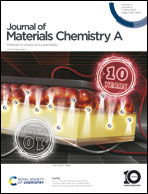The structural evolution of poly(ethylene terephthalate) oligomers produced via glycolysis depolymerization†
Abstract
Polymeric materials have become an integral part of our society, and their high demand has created a large quantity of polymers that end up in the waste stream. For instance, poly(ethylene terephthalate) (PET) is widely used in a broad range of applications, where the chemical recycling of PET is of growing interest. Most methods focus on the complete depolymerization of PET to the monomer, however pushing the equilibrium reaction to the monomer is time- and energy-intensive. We hypothesize that by intercepting intermediates in the depolymerization, telechelic oligomers can be captured that can also be used as reactants to produce value-added goods. To this end, the effect of reaction type, catalyst loading, reaction time, and temperature on the evolution of the product chain structure and yield of the glycolysis depolymerization of PET is studied. For a heterogeneous reaction at lower temperatures (165 °C), the rate of depolymerization is sufficiently slow to offer access to a broad range of molecular weight products (3000–10 000 Daltons) at a high yield (nearly 100%). At higher heterogeneous reaction temperatures (175 and 185 °C), the reaction rate increases, producing oligomers of a narrower molecular weight range (2000–5000 Daltons) with significant loss of the original PET, up to 40%, as water soluble products. In the heterogeneous reaction, little change was observed when altering the catalyst loading at higher temperatures, but lower temperatures and decreased catalyst loading produce accessible higher molecular weight oligomers. Homogeneous catalysis of the glycolysis reactions increases the rate of depolymerization, such that it is difficult to isolate oligomers with Mn > 1000 Daltons. The oligomers from heterogeneous reactions were used as reactants to form block copolymers with ethylene glycol, exemplifying their use as precursors in the production of value-added materials. These experiments, therefore, offer crucial insight into how reaction conditions can be readily tuned to produce target telechelic oligomers of PET.

- This article is part of the themed collection: Polymer Upcycling


 Please wait while we load your content...
Please wait while we load your content...